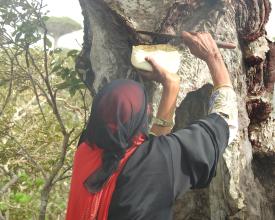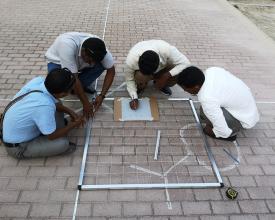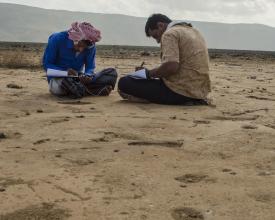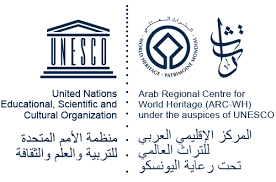
Proyecto del Patrimonio de Soqotra: creación de capacidades locales para la protección del patrimonio cultural y natural único de Socotra

Esta solución se centra en el Proyecto del Patrimonio de Soqotra, un programa multidisciplinar que aborda las necesidades del patrimonio cultural tangible e intangible de Soqotra, uno de los ecosistemas insulares más singulares del mundo y cuya biodiversidad única está en el centro de su condición de Patrimonio de la Humanidad. Mediante el establecimiento de una asociación de instituciones y organizaciones locales e internacionales, el proyecto combina conocimientos multidisciplinares en la documentación y conservación del patrimonio de Soqotra, que es un elemento clave de identidad para las comunidades de Soqotri. El proyecto mejora proyectos y programas anteriores centrados en la conservación de la biodiversidad, y trabaja en la concienciación y la creación de capacidad local para la conservación del patrimonio material e inmaterial como elemento para un futuro desarrollo local sostenible.
El proyecto se centra en reforzar los enfoques comunitarios de conservación del patrimonio, así como en salvaguardar el patrimonio biocultural único de Soqotra.
Contexto
Défis à relever
- Retos medioambientales: cambio de enfoque, de la mera conservación de la biodiversidad a un modelo patrimonial más amplio que englobe los vínculos entre el patrimonio material, inmaterial y natural y los sistemas de conocimiento asociados;
- Retos culturales y sociales: El patrimonio de Soqotri está en peligro por influencias externas; falta de capacidad local, gobernanza y concienciación sobre el patrimonio de Soqotri; falta de recursos patrimoniales disponibles para la toma de decisiones;
- Desafíoseconómicos: falta de oportunidades locales de desarrollo sostenible que se abordan mediante una mayor puesta de relieve y debate sobre el turismo de patrimonio sostenible.
Ubicación
Procesar
Resumen del proceso
La solución se centra en el Proyecto del Patrimonio de Soqotra, un proyecto multidisciplinar en el que participan instituciones y organizaciones locales, nacionales e internacionales de los ámbitos de la conservación de la naturaleza y la salvaguardia del patrimonio. El proyecto se centró en el cambio de perspectivas en la conservación del patrimonio de Soqotra: de la conservación de la biodiversidad a un enfoque interrelacionado más amplio que aborda tanto el patrimonio natural como el cultural como un elemento interrelacionado que está ampliamente interconectado dentro de la vida y la cultura de las personas que son indígenas de la isla y son un componente clave del paisaje biocultural del archipiélago de Soqotra.
El proyecto basa sus actividades principales en el desarrollo y la mejora de las capacidades locales, así como en la mejora de la accesibilidad a la información sobre el patrimonio de Soqotra para permitir una toma de decisiones informada, también a la luz de la planificación de las actividades de turismo sostenible inclusivo que se llevarán a cabo en la isla.
El elemento clave para la aplicación de esta solución es la estrecha cooperación con las comunidades locales y la comunicación y aplicación continuas mediante consultas entre todos los socios del proyecto, con la comunidad de Soqotri en primera línea de la toma de decisiones.
Bloques de construcción
Asociación multidisciplinar del Proyecto de Patrimonio de Soqotra
El Proyecto del Patrimonio de Soqotra está coordinado por el Centro de Plantas de Oriente Próximo (parte del Real Jardín Botánico de Edimburgo) en cooperación con la Universidad Libre de Berlín, el Centro Regional Árabe del Patrimonio Mundial (ARC-WH), el Instituto de Investigación Senckenburg, la Asociación de Cultura y Patrimonio de Soqotra, la Autoridad Yemení de Protección del Medio Ambiente, la Organización General de Antigüedades y Museos (GOAM), Carey Tourism (socio de turismo sostenible) e Stories as Change (producción de películas de narración visual y del proyecto). Además, el proyecto cuenta con el apoyo inicial del Departamento de Digital, Cultura, Medios de Comunicación y Deporte del Reino Unido a través del Fondo de Protección Cultural del British Council. Se están obteniendo más fondos para programas de seguimiento.
El elemento clave de la asociación establecida para el Proyecto del Patrimonio de Soqotra es su carácter interdisciplinario, que aúna distintas experiencias en el campo de la conservación del patrimonio cultural y natural, incluido el patrimonio cultural inmaterial de las comunidades de Soqotri.
La asociación es un elemento fundamental del proyecto, que a través de su carácter interdisciplinario pretende potenciar el enfoque de la biodiversidad mediante un mayor conocimiento del patrimonio cultural aún no totalmente explorado del archipiélago de Soqotra.
Factores facilitadores
El Proyecto del Patrimonio de Soqotra es posible gracias a la ayuda financiera del Departamento de Digital, Cultura, Medios de Comunicación y Deporte del Reino Unido y del British Council recibida a través del Fondo de Protección Cultural, con fondos posteriores a punto de ejecutarse.
La planificación y la comunicación han sido componentes clave para el éxito de las actividades del proyecto. Además, contar in situ con un miembro del personal de ARC-WH que forma parte de la comunidad local y posee los conocimientos necesarios de la lengua indígena facilitó enormemente el éxito de la ejecución del proyecto.
Lección aprendida
El elemento de asociación multidisciplinar es la espina dorsal de la ejecución del Proyecto del Patrimonio de Soqotra. Reunir a instituciones y organizaciones con diferentes enfoques y experiencias en los campos de la conservación del patrimonio cultural y natural, incluido el patrimonio cultural inmaterial, ha sido de vital importancia para el éxito de la ejecución del proyecto.
Contar con el Coordinador del Proyecto de ARC-WH para Socotra in situ, facilitando y pudiendo comunicarse en la lengua indígena local ha permitido una comunicación más eficaz con los participantes en el proyecto y los soqotri locales.
Por último, la simplificación del proceso de gestión del proyecto ha facilitado su ejecución. La asociación multidisciplinar se ha basado en funciones y responsabilidades acordadas que se establecieron al principio del proyecto.
De la conservación de la biodiversidad a un enfoque más amplio del patrimonio natural y cultural
Durante muchos años, los proyectos de conservación de la isla se han centrado exclusivamente en la naturaleza y la biodiversidad. El Proyecto del Patrimonio de Soqotra pretende abordar tanto el patrimonio natural como el cultural como un elemento interrelacionado que está ampliamente interconectado dentro de la vida y la cultura de los pueblos autóctonos de la isla y que son un componente clave del paisaje biocultural del archipiélago de Soqotra.
Este acto de reconexión se establece en primer lugar mediante la identificación y documentación de manifestaciones y expresiones del patrimonio material e inmaterial, así como el establecimiento de actividades de sensibilización. El equipo del proyecto cooperó con un grupo de personas locales interesadas en la documentación de más de 400 bienes del patrimonio cultural material (edificios, monumentos, lugares históricos, así como artefactos y objetos) y de las tradiciones orales e inmateriales -en particular la lengua indígena local y la historia oral- de las comunidades de Soqotri mediante informes, fotografías y películas. Este proceso incluía la consideración de la integración del patrimonio cultural en los sistemas de áreas protegidas diseñados para la conservación de la biodiversidad, y la sensibilización de las comunidades locales sobre la importancia de conservar el patrimonio en su forma más amplia.
Factores facilitadores
La asociación interdisciplinar que respalda el proyecto es la espina dorsal de la aplicación de un enfoque más global del patrimonio.
Además, el hecho de que el miembro del personal local del ARC-WH y el equipo del proyecto estén bien conectados con las principales partes interesadas locales, como los representantes de la Gobernación, el GOAM y la EPA, facilitó la comunicación y difusión de información clave que motivará una ampliación del enfoque puramente de biodiversidad a un enfoque de conservación más centrado en la naturaleza y la cultura.
Lección aprendida
El proyecto se centró en cuestionar la separación existente entre naturaleza y cultura, que sigue estando ampliamente integrada en el pensamiento conservacionista. Esta división también puede encontrarse en las diferencias entre la comprensión y el pensamiento de las comunidades locales y la influencia profesional externa. Un elemento clave para superar estas divisiones ha sido la participación de las comunidades locales de Soqotri en la puesta en marcha, planificación y ejecución del proyecto, incluyendo debates con profesionales locales y miembros de la comunidad que representan los intereses de las comunidades de Soqotri.
El proyecto ha permitido reconocer y explorar las diferencias existentes entre la teoría y la práctica de la conservación de la biodiversidad y el patrimonio, así como la necesidad de considerar enfoques novedosos por parte de todos los participantes para adaptarse a un sistema local, especialmente cuando este sistema es un archipiélago relativamente aislado y en el que la gobernanza o las infraestructuras para la conservación y gestión del patrimonio son escasas o inexistentes.
Creación de capacidades a nivel local
El desarrollo de las capacidades locales y la sensibilización constituyen el núcleo del Proyecto del Patrimonio de Soqotra, que incluye tanto la formación de los profesionales del patrimonio como la de los miembros de las comunidades locales. Aprovechar la capacidad local existente es fundamental para la implementación a largo plazo de esfuerzos eficaces de conservación y gestión, con especial atención en garantizar la inclusión del patrimonio en el desarrollo local sostenible, así como en garantizar la sostenibilidad de las comunidades locales.
Entre 2018-2020, los miembros del equipo del proyecto se reunieron en el Centro Regional Árabe para el Patrimonio Mundial en Manama, Bahrein, cuatro veces para talleres de capacitación sobre el reconocimiento, la documentación y el registro del patrimonio cultural en Soqotra. La formación en documentación del patrimonio cultural incluyó métodos de estudio detallados para una serie de yacimientos, así como formación especializada en el registro del arte rupestre y en el uso de la fotografía aérea con cometa. El registro del patrimonio inmaterial incluyó formación detallada en cinematografía para poder dar vida a todos los detalles de las prácticas tradicionales. También se impartió formación en técnicas de educación y sensibilización, presentación y narración de historias. Además, los miembros interesados de la comunidad de Soqotri han participado directamente en la documentación de los bienes del patrimonio cultural.
Factores facilitadores
El primer factor facilitador es garantizar que se cumplieran los requisitos del equipo local y se ajustaran a los resultados estratégicos acordados por los socios y las partes interesadas del proyecto.
A ello contribuyó también la participación sobre el terreno del coordinador del proyecto de ARC-WH para Socotra, que habla con fluidez inglés, árabe y soqotri, lo que facilitó la comunicación y la transmisión de conocimientos.
La disponibilidad de fondos para viajes a fin de impartir formación presencial e in situ es fundamental para garantizar la eficacia de estas actividades.
Lección aprendida
- Para que las actividades de capacitación sean buenas e integradoras es necesaria una estrecha colaboración entre los socios del proyecto, que aportan conocimientos complementarios.
- La inclusión específica de mujeres en el programa de desarrollo de capacidades, permitiéndoles ampliar sus conocimientos técnicos, es una clara rareza en una sociedad indígena como la que existe en Soqotra, donde las mujeres tradicionalmente se abstienen (o no siempre se benefician de la igualdad de oportunidades) de desempeñar papeles clave en las actividades públicas. La inclusión de las mujeres soqotri permitió acceder a fuentes de información que de otro modo no habrían sido accesibles.
- Es fundamental recabar información a lo largo de todo el proceso de formación para garantizar que los miembros del equipo cuentan con las competencias necesarias, así como con la experiencia necesaria para transmitirlas a las comunidades y a los profesionales locales.
- Los servicios de traducción de alta calidad son necesarios para poder comunicarse adecuadamente y relacionarse con las comunidades y los agentes locales. Además, la participación directa de profesionales del patrimonio con conocimientos de lenguas indígenas es un activo fundamental para impartir con eficacia la formación y el desarrollo de capacidades.
Recursos para la toma de decisiones
Un componente clave del Proyecto del Patrimonio de Soqotra es la capacidad de acceder a la información sobre el patrimonio de Soqotra para permitir la toma de decisiones. Esto se hizo realidad incorporando todo el patrimonio material e inmaterial documentado a la Base de Datos del Patrimonio de Soqotra, puesta en marcha a través del Proyecto Arcos. Aunque se mantiene externamente, y aunque las conexiones a Internet en Soqotra impiden el acceso a tales recursos de manera significativa, el equipo local tiene acceso a toda la información a través de la aplicación Arches Collector App, que puede utilizarse para visualizar la información, y también para recopilar y añadir información sobre el terreno.
Las actualizaciones pueden verificarse y habilitarse en reuniones periódicas en el Centro Regional Árabe del Patrimonio Mundial hasta que se habilite un suministro sostenible de Internet en Soqotra.
Esto ha permitido a las partes interesadas de Soqotra acceder a la información con fines de planificación y sensibilizar a los interesados sobre la importancia de tener en cuenta los componentes del patrimonio en las actividades de desarrollo.
Factores facilitadores
El elemento constitutivo requería el suministro y mantenimiento adecuados de la base de datos central en un lugar seguro, así como la capacidad de actualizar periódicamente la información y acceder a ella.
Lección aprendida
Las soluciones en línea no son apropiadas para Soqotra mientras las conexiones y la disponibilidad de Internet sean insostenibles y de baja calidad. Esto se aplica a TODAS las soluciones sostenibles en Soqotra y no se limita a los programas de patrimonio.
La provisión de una aplicación fuera de línea es el primer paso, pero requiere actualizaciones rutinarias que sólo pueden llevarse a cabo a expensas de los viajes internacionales y la disponibilidad de vuelos.
Turismo patrimonial sostenible
Soqotra es un destino turístico "de visita obligada", tanto más cuanto que es difícil llegar a él y cuesta trabajo hacerlo cuando se llega. La infraestructura turística local no está bien establecida y los agentes locales ofrecen oportunidades muy similares y restrictivas para visitar un número reducido de localidades.
El Proyecto de Patrimonio de Soqotra trató de cambiar este comportamiento documentando lugares y prácticas y elaborando un itinerario más amplio que pudiera ofrecer un valor añadido a los turistas, los agentes locales y los operadores globales, al tiempo que aumentaba la conservación de los lugares y las localidades gracias a la diversificación.
Ahora se vuelve a hablar del turismo patrimonial sostenible como posible mecanismo de mejora de los medios de subsistencia en Soqotra, al tiempo que se abordan posibles mecanismos para contribuir directamente a las medidas de conservación del patrimonio.
Factores facilitadores
Participación de un consultor experto en turismo sostenible (Carey Tourism) con conocimientos y experiencia en este contexto geográfico específico y con experiencia regional en lugares menos conocidos.
Para ello fue necesario obtener y garantizar el acceso a las partes interesadas del sector turístico a todos los niveles.
Lección aprendida
Trabajar para revitalizar las ideas del turismo sostenible en un lugar con infraestructuras y aplicación de la ley deficientes, con opciones de viaje muy limitadas y en un escenario de conflicto a escala nacional, con escaso acceso a las partes interesadas regionales y mundiales más allá de la industria turística directa, supone un gran reto para lograr resultados prácticos y medibles.
Se trata de un trabajo en curso.
Impactos
El proyecto Patrimonio de Soqotra se centra en aumentar el conocimiento y la concienciación sobre el patrimonio cultural del archipiélago de Soqotra.
- Impactos medioambientales y culturales: el proyecto Patrimonio de Soqotra abordó tanto el patrimonio natural como el cultural en el mismo marco, dando los primeros pasos hacia el reconocimiento del patrimonio cultural de Soqotra y su inclusión en la planificación de áreas protegidas. Además, a través del proyecto ARCHES se creó la Base de Datos del Patrimonio de Soqotra.
- Impactos económicos: el proyecto abrió el debate sobre el turismo patrimonial con las comunidades locales y las partes interesadas; esto también fomentó y publicitó la conservación a través de la diversificación.
- Impactos sociales y culturales: gracias al proyecto, se ha formado a profesionales locales del patrimonio y se han desarrollado las capacidades locales. A nivel local, se han puesto en marcha una serie de actividades de sensibilización sobre el patrimonio, como la interpretación de los yacimientos, festivales del patrimonio, "tebeos" sobre el patrimonio, visitas escolares y de las partes interesadas, y medios de comunicación en línea. El proyecto fomentó el uso de talleres colaborativos de teatro y cine para volver a conectar a las generaciones con su propio patrimonio.
Beneficiarios
Los beneficiarios son las comunidades locales que viven en la isla -que también son actores clave en la ejecución de este proyecto- y la comunidad científica, que se beneficia de la documentación arqueológica realizada por las comunidades locales.
Objetivos de Desarrollo Sostenible
Historia

Durante el Proyecto del Patrimonio de Soqotra, dos mujeres yemeníes -Sheikha Mubarak y Ahdab Al-Ameri- recibieron formación sobre técnicas de documentación en vídeo e investigación mediante entrevistas. Estaban decididas a documentar el patrimonio inmaterial de Soqotra y a lo largo de seis meses recopilaron más de 50 horas de metraje que luego editaron en colaboración con el cineasta Oliver Wilkins en una pequeña película que documenta canciones, poesía, historias y artesanía tradicional de Socotri.
La película se presentó en la conferencia anual de Amigos de Socotra, donde fue vista por un numeroso público de académicos, antropólogos, profesionales del desarrollo y habitantes de Soqotri. Captaron en película muchas tradiciones únicas de los soqotri que habían permanecido ocultas a los investigadores extranjeros.
Esta película y este proyecto demuestran claramente la importancia del vídeo para documentar y compartir el patrimonio inmaterial y la necesidad de situar a la población local en el centro de cualquier investigación cultural.
Vea la película de Sheikha y Ahdab en https://vimeo.com/300351147





























